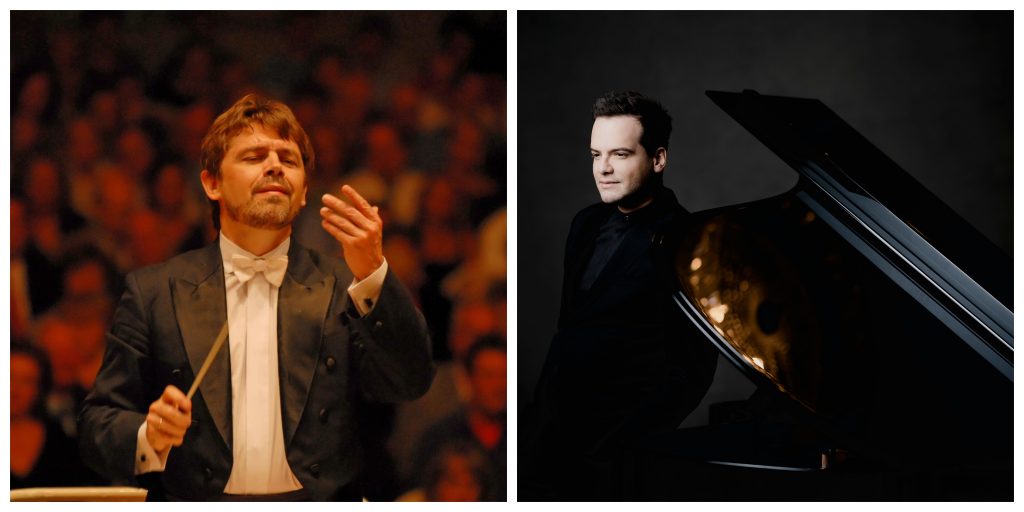by Timothy Robson

In 1809 Beethoven completed his Fifth Piano Concerto (now commonly known in English-speaking countries as the “Emperor” for reasons uncertain). He was too deaf to perform the solo part at its premiere in 1811 in Leipzig. The work greatly expanded the traditional Classical-era concerto form in both duration and development, making it perhaps the first real concerto of the Romantic period.
Boreyko’s and Piemontesi’s interpretation was grand enough to fill the vast Blossom space comfortably, yet there were many sections full of beautifully refined details. With the exception of the passage of staccato octaves in the piano toward the end of the first movement, where the soloist covered the orchestra, the balance between them was compatible.
The second movement was a perfect example of sustained serenity and delicacy. We were reminded of Beethoven’s genius in making beautiful music out of the simplest of means: descending scales, with a leap up, repeated several times in variation. Later, lovely piano trills ascended with purity. The soft connective passage between the slow second movement and the rondo was quiet, seemingly tentative at first. But when the solo piano roared out the rondo theme, it was clear that the transition had been calculated to mark the difference between the movements. Piemontesi’s playing in the third was often thunderous, but with polished sound, never any metallic hammering. He and Boreyko were excellent collaborators, with consistent precision of ensemble.
After an extended ovation, Francesco Piemontesi obliged the audience with an encore: a luminous performance of Schubert’s Impromptu No. 2 in A-flat, D. 935. The pianist’s understated playing of this modest masterpiece held the audience rapt.
Alexander Zemlinsky was a composer who happened to come along at the wrong time in musical history. Born in 1872, he was a contemporary and colleague of Gustav Mahler, Arnold Schoenberg, and Richard Strauss. (Zemlinsky courted Alma Schindler, who dumped him to marry Mahler.) While Schoenberg’s music veered toward atonality, Zemlinsky stuck to the ambiguous tonality of early Schoenberg, Strauss, and Mahler. The others became famous, while Zemlinsky slid into obscurity, though some of his works have undergone a revival in recent years.
His tone poem (or, in his words, “fantasy for orchestra”) Die Seejungfrau should be played more often, though it appeared that Saturday’s Blossom audience couldn’t wait to get out at the piece’s end. The three-movement work is based on Hans Christian Andersen’s story The Mermaid — which was later turned into Dvořák’s opera Rusalka and, in our own time, Disney’s The Little Mermaid. (Unlike the Disney version, Andersen’s tale doesn’t have a happy ending, although the mermaid is redeemed.)
Like Schoenberg’s similar Pelleas und Melisande, which premiered at the same concert in 1905, Zemlinsky’s The Mermaid is freighted with the psychological gobbledygook that was fashionable among the Viennese intelligentsia of the time. But whereas Schoenberg’s music for Pelleas is morbidly turgid, wandering through tonalities from moment to moment, The Mermaid is more traditionally Romantic — although key centers are still constantly shifting. Zemlinsky’s music can be magical in its clarity despite its often thick orchestration, with swirling passages for harp and strings that depict the sea, and huge masses of brass at emotional climaxes.
The story’s characters are depicted in lengthy orchestral solos. There were too many very fine soloists to mention, but special note goes to violinist Peter Otto and English hornist Corbin Stair, who were often paired in dialogue throughout. Andrey Boreyko led the proceedings with aplomb, and Zemlinsky’s textures were easily put together by the Orchestra, which deserves great acclaim for the outstanding achievement that this performance was.
Published on ClevelandClassical.com August 6, 2019.
Click here for a printable copy of this article



